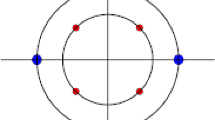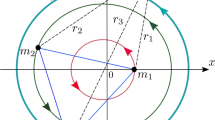Abstract
General conditions for the existence of stable, minimum energy configurations in the full N-body problem are derived and investigated. Then the minimum energy and stable configurations for the spherical, equal mass full body problem are investigated for \(N = 2, 3, 4\). This problem is defined as the dynamics of finite density spheres which interact gravitationally and through surface forces. This is a variation of the gravitational N-body problem in which the bodies are not allowed to come arbitrarily close to each other (due to their finite density), enabling the existence of resting configurations in addition to orbital motion. Previous work on this problem has outlined an efficient and simple way in which the stability of configurations in this problem can be defined. This methodology is reviewed and derived in a new approach and then applied to multiple body problems. In addition to this, new results on the Hill stability of these configurations are examined and derived. The study of these configurations is important for understanding the mechanics and morphological properties of small rubble pile asteroids. These results can also be generalized to other configurations of bodies that interact via field potentials and surface contact forces.
Access this chapter
Tax calculation will be finalised at checkout
Purchases are for personal use only
Similar content being viewed by others
References
Cendra H, Marsden JE (2005) Geometric mechanics and the dynamics of asteroid pairs. Dyn. Syst. Int. J. 20:3–21
Greenwood, D.T.: Classical Dynamics. Dover (1997)
Hampton M, Moeckel R (2006) Finiteness of relative equilibria of the four-body problem. Inventiones Math 163(2):289–312
Jacobson SA, Scheeres DJ (2011) Dynamics of rotationally fissioned asteroids: source of observed small asteroid systems. Icarus 214:161–178
Moeckel R (1990) On central configurations. Math Z 205(1):499–517
Pravec P, Vokrouhlickỳ D, Polishook D, Scheeres DJ, Harris AW, Galád A, Vaduvescu O, Pozo F, Barr A, Longa P et al (2010) Formation of asteroid pairs by rotational fission. Nature 466(7310):1085–1088
Scheeres DJ (2002) Stability in the full two-body problem. Celest Mech Dyn Astron 83(1):155–169
Scheeres DJ (2006) Relative equilibria for general gravity fields in the sphere-restricted full 2-body problem. Celest Mech Dyn Astron 94:317–349
Scheeres DJ (2012) Minimum energy configurations in the n-body problem and the celestial mechanics of granular systems. Celest Mech Dyn Astron 113(3):291–320
Scheeres DJ (2014) Hill stability in the full 3-body problem. Proc Int Astron Union 9(S310):134–137
Scheeres DJ (2015) Stable and minimum energy configurations in the spherical, equal mass full 4-body problem. In: International conference on computational and experimental engineering and sciences, special symposium on computational methods in celestial mechanics
Simo JC, Lewis D, Marsden JE (1991) Stability of relative equilibria. Part I: the reduced energy-momentum method. Arch Ration Mech Anal 115(1):15–59
Smale S (1970) Topology and mechanics. I. Inventiones Math 10(4): 305–331
Smale S (1970) Topology and mechanics. II. Inventiones Math 11(1): 45–64
Acknowledgments
The author acknowledges support from NASA grant NNX14AL16G from the Near Earth Objects Observation programs and from NASA’s SSERVI program (Institute for the Science of Exploration Targets) through institute grant number NNA14AB03A.
Author information
Authors and Affiliations
Corresponding author
Editor information
Editors and Affiliations
Rights and permissions
Copyright information
© 2016 Springer International Publishing Switzerland
About this chapter
Cite this chapter
Scheeres, D.J. (2016). Relative Equilibria in the Full N-Body Problem with Applications to the Equal Mass Problem. In: Bonnard, B., Chyba, M. (eds) Recent Advances in Celestial and Space Mechanics. Mathematics for Industry, vol 23. Springer, Cham. https://doi.org/10.1007/978-3-319-27464-5_2
Download citation
DOI: https://doi.org/10.1007/978-3-319-27464-5_2
Published:
Publisher Name: Springer, Cham
Print ISBN: 978-3-319-27462-1
Online ISBN: 978-3-319-27464-5
eBook Packages: EngineeringEngineering (R0)




